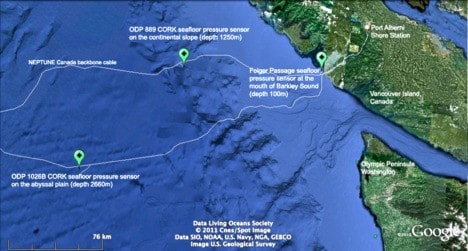Water monitoring equipment detected sudden changes in water conditions near Port Alberni even though a large tsunami never rolled up the inlet.
A tsunami advisory was triggered for B.C.’s north, central and west coasts' after an earthquake measuring 8.9 on the Richter scale crushed the north east coast of Japan late Thursday night.
NEPTUNE Canada’s sensor array across the Juan de Fuca Strait detected significant water pressure activity early Friday morning.
“The sensors picked up a tsunami but it was small by the time it got to us,” said Mairi Best, NEPTUNE associate director of science.
The sensors record changes in the water pressure above them and can detect variances as little as a centimetre or a few millimetres.
Sensor data is transmitted to NEPTUNE's shore station in Port Alberni via fiber optic cable then relayed to the University of Victoria.
“We first saw pressure graph spikes at 6:35 a.m. when it arrived as a 15 centimetre wave,” Best said.
“We saw the pressure graph m spike at 7:30 a.m. in the Barkley Sound.”
There may have been activity in Alberni later in the day as well.
Tseshaht Councillor Luke George and three other tribe members saw what they thought was a small wave roll up the river by the Tseshaht administration building at 3 p.m.
"It was maybe a foot high, the same size as a wave a big boat might produce," George said.
The wave rolled past the sand bar and continued around the corner of the orange bridge.
"You could hear a big sloshing sound by the rocks under the bridge when it passed by," George said.
"And the water was really muddy around the sand bar after."
NEPTUNE detected a 40 cm wave over a sensor between Ucluelet and Bamfield at about 7:15 a.m..
Tidal gauges at the Bamfield Marine Station registered unusual water activity as well.
"There were big swirling currents and a lot of mud was also kicked up in the Inlet," said Anne Stewart, the station's public education coordinator.
"You could tell that something big was happening."
One person at the station who never got the advisory paddled to work in his kayak.
"He said that the water was unusually muddy and rough," Stewart said.
It’s not the first time NEPTUNE’s sensors detected tsunami fallout in the Barkley Sound or Alberni Canal.
The sensors detected water pressure changes after earthquakes in Samoa in 2009 and Chile in 2010.
“This was a bigger wave than those ones though,” Mairi said.
The sensors even detected water pressure changes from a recent storm from a depth of 100 metres.
NEPTUNE shares its data with the Department of Fisheries and Oceans, which is responsible for handling tsunami response in Canada.
The data also go to IRIS, the global network of earthquake information.
“Their scientists integrate it with their tsunami models to try and better understand how a tsunami behaves when it integrates with our coast,” Mairi said.
“This is a very real threat, and we need to be prepared for it.”
reporter@albernivalleynews.com
*The tsunami advisory has been cancelled but Port Alberni was ready. Read more here.
